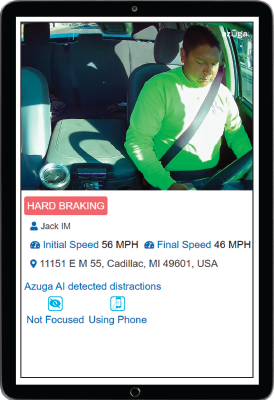By Barbara Hernandez-Taylor
Driver safety is integral to the operation of a successful fleet as drivers spend countless hours on the road. Fleet managers promote driver safety, but they cannot control unforeseeable risks like distracted driving, harsh braking, and other dangerous driving habits. To improve long-term driver safety, fleets should leverage video technology coupled with machine learning as part of their safety strategy.

ACCIDENTS ARE COSTLY
According to the American Trucking Association, 70% of all accidents are not the fault of the commercial driver, yet, in most cases, the company is deemed at fault, which can be highly expensive for employers. Occupational Safety and Health Administration (OSHA) cites the National Highway Traffic Safety Administration’s (NHTSA) statistic that motor vehicle accidents cost employers $60 billion every year in lost productivity, medical care, legal expenses, and property damage. OSHA emphasizes that accidents also increase the cost of benefits like Social Security, worker’s compensation, and disability insurance.
Moreover, the average cost of a vehicle crash is $16,500 for the employer, and if a worker is injured in the crash, the cost to their employer increases to $74,000. When a fatality occurs, the cost to an employer could be over $500,000. All of this increases the cost of overhead for fleets. Needless to say, fleets should prioritize the improvement of driver safety and reduce or even eliminate vehicular collisions.

RISKY BEHAVIORS
The National Highway Traffic Safety Administration (NHTSA) recently announced its preliminary estimates for motor vehicle fatalities in the second quarter of 2020. The data suggests that since April, the fatality rate has increased along with a potential trend toward risky driving behaviors in the wake of the COVID-19 pandemic. According to the Virginia Tech Transportation Institute, several early studies suggest that there has been an increase in risky driving behaviors resulting from changing travel patterns, including increased speeding, distracted driving, and decreased seat belt usage have been reported.

VIDEO & SAFETY
Because safety is so important, it is no coincidence that there has been a dramatic proliferation in the number of GPS telematics providers adding video telematics to their solutions. The value of video telematics is that it allows a company to capture what happened. Now, with the inclusion of more precise location tracking, companies can use video telematics to identify dangerous driving behaviors, including harsh braking, accelerating, and distracted driving.
Fleets can use telematics data to identify drivers that exhibit dangerous driving behaviors so they can work to correct them before the accident occurs. Having video documentation of dangerous driving behaviors can help in coaching and training drivers. Video telematics allows companies to obtain real-time video as evidence of an incident that often absolves the company and identifies the driver at fault in an accident. This essentially creates a highly accurate virtual eye witness at the scene of every accident with a documented view of both in-cab and road-facing events.

MONITOR DRIVERS
With video technology, fleets can monitor all aspects of their vehicles. A forward-facing camera can record the driver’s road view and, in some cases, even analyze road and weather conditions.

Fleets may also wish to monitor inside the vehicle’s cab. A camera placed inside the vehicle can monitor the driver for distractions and other bad behaviors, like not wearing a seat belt or using a mobile phone while the vehicle is in motion. Rear-mounted cameras can record the road behind the vehicle. They capture incidents where the driver is rear-ended, in addition to situations where the driver is involved in a collision while in reverse. Some fleets choose to install video technology on the sides of their vehicles to capture sideswiping incidents that would be missed by the front or rearview cameras.
Advancements in AI video telematics technology like Driver Monitoring Systems (DMS) and Advanced Driver Assistance Systems (ADAS) increase data accuracy. DMS enables fleet leaders to monitor activities such as eye movement, face ID head posture, and detect distracted driving such as phone usage, fatigue, and smoking. ADAS technology provides additional data including forward-collision warnings, early lane departures, and detects objects like road signs, traffic lights, and pedestrians.
One company, Azuga, uses Cloud-AI technology with its SafetyCam to detect unsafe driving behaviors and provide managers with actionable insights to improve driver and fleet safety. When risky driving events are detected, Azuga SafetyCam captures video and processes them through its artificial intelligence (AI)-engine. Events are tagged by distracted driving behaviors to help fleets identify underlying causes of risky events.

LEGAL BENEFITS
Video technology can also play an integral role in investigating and reducing vehicular accidents. Video telematics can capture data—video and audio—surrounding an incident to accurately determine who was at fault. Many telematics services automatically upload footage after a safety incident to the cloud for data protection. Fleet managers can identify if driver error was involved in a crash and can easily fight fraudulent claims with video technology. Drivers have proof when they are not at fault for an accident. Owning video technology-equipped vehicles can ultimately save fleets from frivolous, costly lawsuits. Companies report that having video proof of what happened saved thousands if not hundreds of thousands of dollars in possible payouts and insurance claims.

RESPONSIBILITY
Ensuring driver safety is a challenge for fleet managers because drivers often engage in unknown dangerous or distracted driving behaviors. Some fleet managers have difficulty identifying which drivers are engaging in poor driving decisions before it’s too late. Today, fleet managers can employ video technology to monitor drivers, promote safety, and train others on good driving habits. Furthermore, video technology captures the truth of an accident, assisting the company as well as the drivers. Fleet managers who aim to improve driver safety should explore purchasing video technology for their vehicles.
Commit to safety as part of your company values and install durable systems to make safety a priority every day. Encouraging safe driving with transparency as implementing a fleet management solution should never be a surprise to the driver. Instead, telematics technology should reward safe driving behaviors so that everyone benefits, including fleet-based businesses, managers, drivers, and the communities in which they operate.
ABOUT THE AUTHOR
Barbara Hernandez-Taylor is the head of product marketing for Azuga—a leader in fleet management software. The Azuga data science team has conducted intensive research with its install base and has conducted hundreds of customer interviews, which informed this article. Find out more about Azuga’s video telematics technology, visit www.azuga.com/dashcam.




